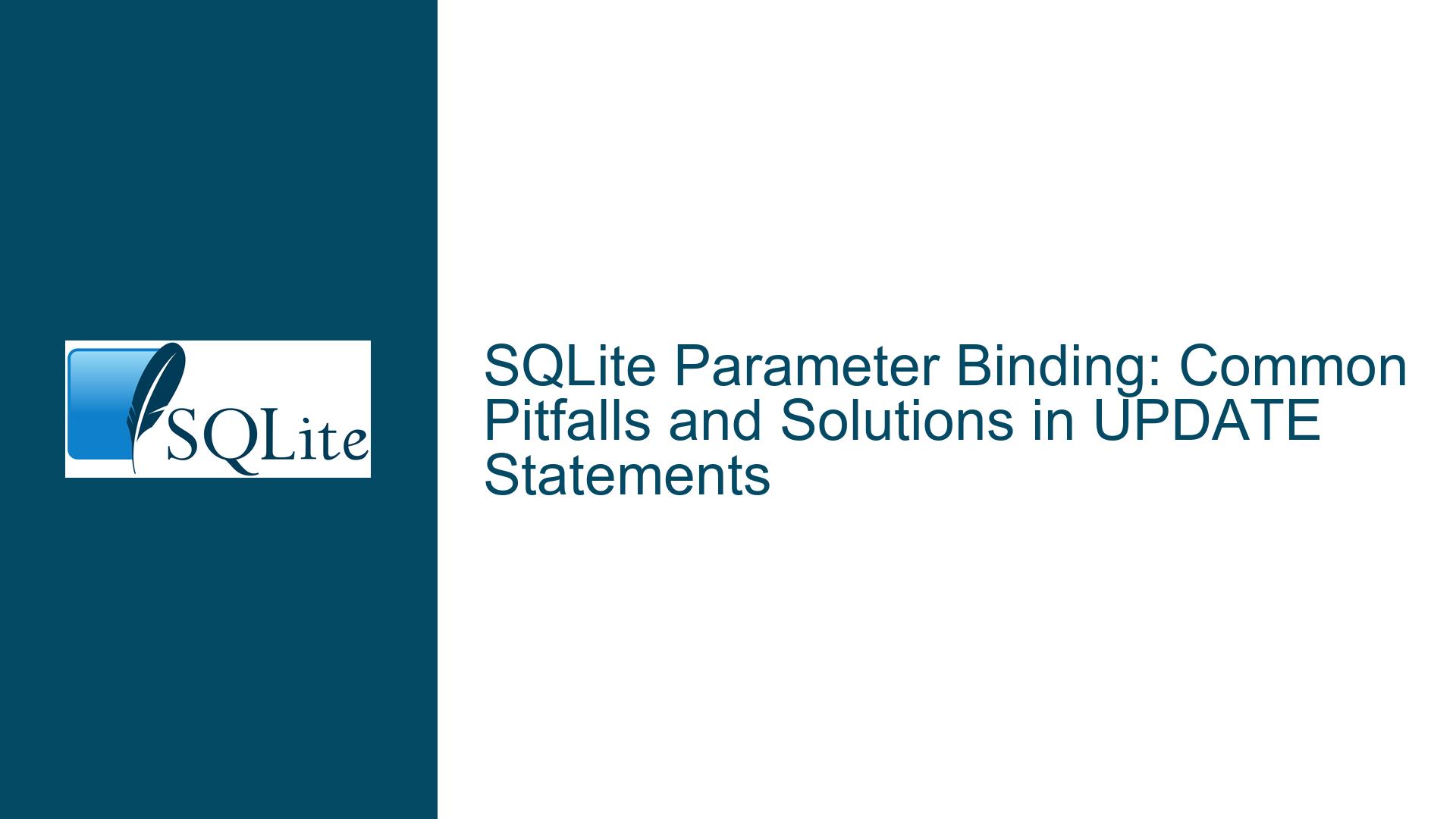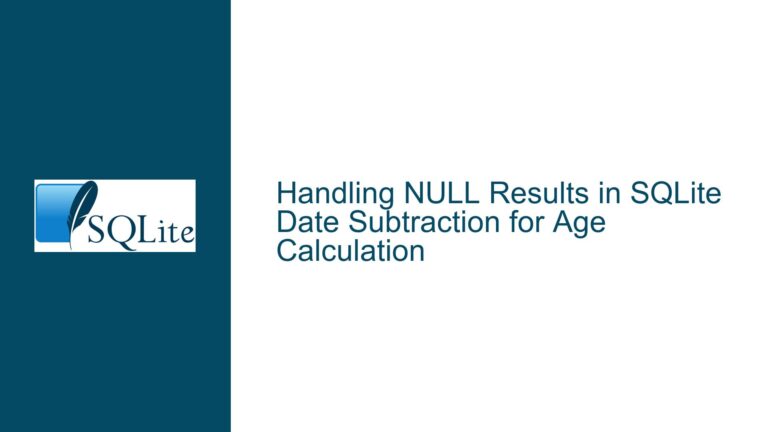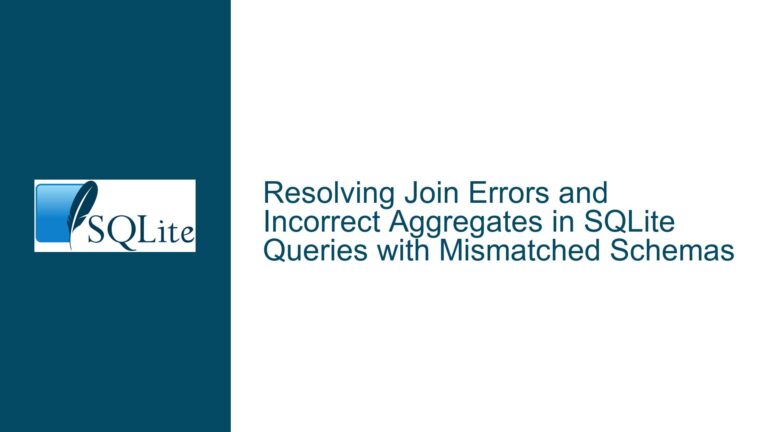SQLite Parameter Binding: Common Pitfalls and Solutions in UPDATE Statements
Misuse of Parameter Binding in SQLite UPDATE Statements
One of the most common issues developers face when working with SQLite is the misuse of parameter binding, particularly in UPDATE statements. Parameter binding is a powerful feature that allows developers to separate SQL code from data, improving both security and performance. However, it is often misunderstood, leading to errors such as the inability to bind column names or values correctly. This issue is particularly prevalent in dynamic SQL generation, where column names or values are determined at runtime.
The core problem arises when developers attempt to use parameter binding for schema elements, such as column names, or when they incorrectly assume that all placeholders (?) in a query can be replaced with bound parameters. SQLite’s parameter binding mechanism is designed to replace placeholders with values, not with schema elements like table names or column names. This misunderstanding can lead to queries that fail to execute or, worse, expose the application to SQL injection attacks.
For example, consider the following Python code snippet:
cursor.execute('''UPDATE ASSETS SET ? = '?' WHERE ID = ?''', (updateColumn, setValue, updateIndex))
This query attempts to use parameter binding for both the column name (updateColumn) and the value (setValue). However, SQLite does not support binding column names, and the literal '?' is treated as a string containing a question mark, not as a placeholder for a bound parameter. This results in a query that fails to execute as intended.
Interrupted Query Compilation Due to Invalid Parameter Binding
The root cause of the issue lies in the way SQLite compiles and executes queries. When a query is prepared, SQLite parses the SQL statement and compiles it into an internal representation. During this process, placeholders (?) are replaced with bound parameters, but only in positions where values are expected. Schema elements, such as column names, are not subject to this replacement because they affect the structure of the query itself.
For instance, in the query UPDATE ASSETS SET ? = '?' WHERE ID = ?, the first placeholder (?) is intended to represent a column name. However, SQLite cannot compile this query because the column name is not known at the time of preparation. This interrupts the query compilation process, leading to an error.
Additionally, the use of single quotes around the second placeholder ('?') causes it to be interpreted as a literal string rather than a placeholder for a bound parameter. This further complicates the query, as the intended value (setValue) is not bound correctly.
The confusion is compounded when developers compare this behavior to other SQL statements, such as INSERT, where parameter binding works as expected. For example:
conn.execute("""INSERT INTO ASSETS(NAME, LICENSE, QUANTITY, HOSTNAME) VALUES (?, ?, ?, ?)""", (name, key_object.encrypt(license), quantity, hostname))
In this case, the placeholders are correctly used to represent values, and the query compiles and executes without issue. This discrepancy often leads developers to assume that the problem lies with SQLite itself, rather than with their understanding of parameter binding.
Implementing Safe and Effective Parameter Binding in SQLite
To resolve the issue, developers must understand the limitations of parameter binding and adopt strategies that ensure both correctness and security. Below are detailed steps and solutions for implementing safe and effective parameter binding in SQLite UPDATE statements.
Using Python String Formatting for Column Names
Since SQLite does not support parameter binding for column names, developers must use alternative methods to dynamically insert column names into queries. One common approach is to use Python’s string formatting capabilities. For example:
cursor.execute('UPDATE ASSETS SET [{0}] = ? WHERE ID = ?'.format(updateColumn), (setValue, updateIndex))
In this example, the column name (updateColumn) is inserted into the query using Python’s format method. The square brackets around the column name ensure that any special characters are handled correctly. The values (setValue and updateIndex) are bound using parameter binding, ensuring that they are properly escaped and protected against SQL injection.
Avoiding SQL Injection with Proper Escaping
When dynamically generating SQL queries, it is crucial to avoid SQL injection vulnerabilities. Directly concatenating user input into a query can lead to severe security issues. For example:
sql_update = "UPDATE ASSETS SET {0} = '{1}' WHERE ID = {2}".format(updateColumn, setValue, updateIndex)
If setValue contains malicious input, such as "haha'; DROP TABLE ASSETS; --", the resulting query could delete the entire ASSETS table. To prevent this, always use parameter binding for values and ensure that column names are properly escaped.
Combining String Formatting and Parameter Binding
A robust solution combines string formatting for column names with parameter binding for values. This approach ensures that the query is both dynamic and secure. For example:
cursor.execute('UPDATE ASSETS SET [{0}] = ? WHERE ID = ?'.format(updateColumn), (setValue, updateIndex))
Here, the column name is safely inserted using string formatting, while the values are bound using parameter binding. This approach minimizes the risk of SQL injection and ensures that the query executes correctly.
Using Prepared Statements for Repeated Queries
For queries that are executed repeatedly with different values, consider using prepared statements. Prepared statements are precompiled queries that can be executed multiple times with different parameters. This improves performance and reduces the risk of errors. For example:
query = 'UPDATE ASSETS SET [{0}] = ? WHERE ID = ?'.format(updateColumn)
cursor.execute(query, (setValue, updateIndex))
By preparing the query once and executing it multiple times, you can avoid the overhead of recompiling the query and ensure consistent behavior.
Validating Input and Column Names
Before executing a dynamically generated query, validate both the input values and the column names. Ensure that column names match the expected schema and that input values are within acceptable ranges. This additional layer of validation can prevent errors and improve the robustness of your application.
Example: Full Implementation
Below is a complete example demonstrating the correct use of parameter binding and string formatting in an UPDATE statement:
def update_asset(cursor, updateColumn, setValue, updateIndex):
# Validate column name
valid_columns = ["NAME", "LICENSE", "QUANTITY", "HOSTNAME"]
if updateColumn not in valid_columns:
raise ValueError(f"Invalid column name: {updateColumn}")
# Construct and execute the query
query = 'UPDATE ASSETS SET [{0}] = ? WHERE ID = ?'.format(updateColumn)
cursor.execute(query, (setValue, updateIndex))
This function validates the column name, constructs the query using string formatting, and executes it with parameter binding. It ensures that the query is both dynamic and secure.
By understanding the limitations of parameter binding and adopting best practices for dynamic SQL generation, developers can avoid common pitfalls and ensure that their SQLite queries are both efficient and secure. The key is to use parameter binding for values, string formatting for schema elements, and rigorous input validation to prevent errors and vulnerabilities.






